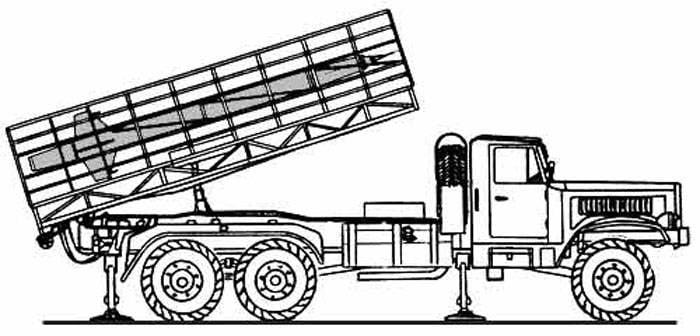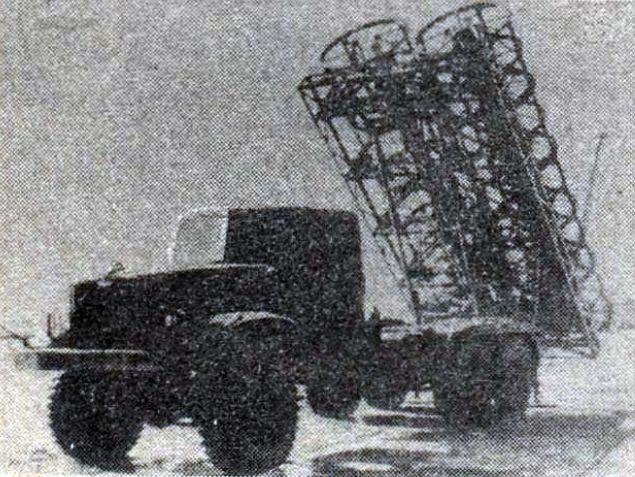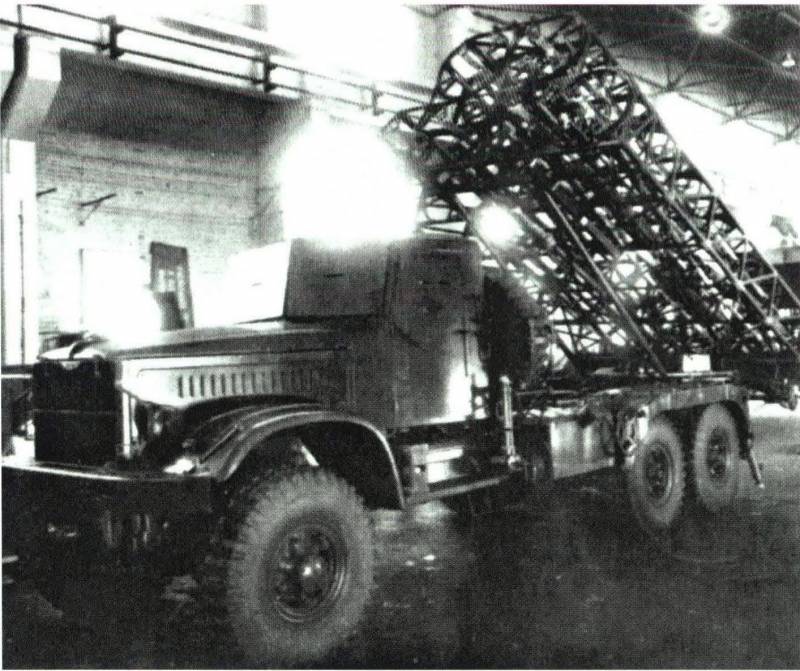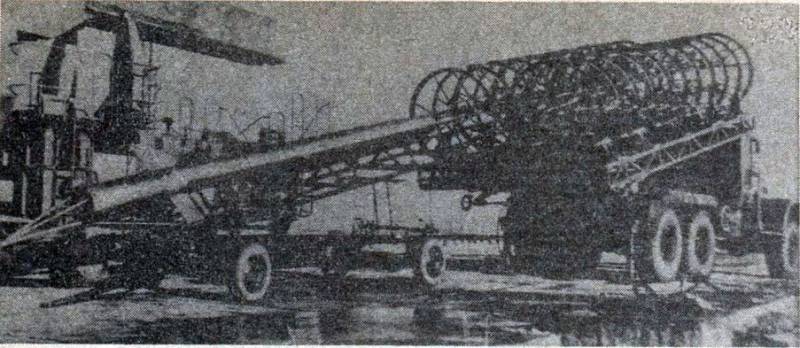Tactical missile system 036 "Whirlwind"
Tactical unguided missiles created by the mid-fifties of the last century had some drawbacks. So, the low perfection of solid fuel did not allow to obtain high range performance, and liquid engines, providing the required range, were too complicated, expensive and not reliable. Continuing the development of such engines, Soviet designers were engaged in experiments, the purpose of which was to search for alternatives with the required characteristics. One of the best options for replacing solid and liquid engines then seemed to be a direct-flow system.
At the stage of preliminary calculations and the formation of requirements for a promising rocket, it was determined that the use of a supersonic ramjet engine (SPVRD), working on standard gasoline B-70, will send 450-kg rocket at a distance of up to 70 km. Given the required supply of fuel, such a projectile could carry an 100-kg warhead with an explosive charge of 45 kg. The big advantage of such a rocket was the ability to change the firing range without changing the elevation angle of the launcher: to achieve the flight parameters required in this situation, you could use a mechanism that turned off the fuel supply to the engine.

Scheme self-propelled launcher Br-215. Figure Dogswar.ru
By the beginning of 1958, preliminary work was completed on a promising mobile field reactive system with an unguided rocket. It should be noted that the modern classification of military equipment makes it possible to consider this development as a tactical missile system or (with some reservations) a multiple launch rocket system. 13 February 58 was issued a decree of the USSR Council of Ministers on the development of a new draft of the 036 Vortex missile system. About two months later, the Main Artillery Directorate completed the work on the technical assignment. The development of a new project was entrusted to OKB-670, the main designer was appointed MM. Bondaryuk.
The aim of the project was to create a missile system capable of striking enemy targets in tactical and near operational depths. The objectives of the "Whirlwind" should have been the reserves of the enemy in the form of manpower and military equipment, firing positions of artillery, headquarters, communications centers, assembly sites tactical nuclear weapons, rear objects, etc. To hit such targets with the help of unguided missiles, it was necessary to use the simultaneous launch of several ammunition, which made it possible to bring the probability of hitting enemy targets to acceptable values.
By this time, the development organization had already had some experience in creating tactical unguided missiles, which should have been used in a new project. The use of experience, as well as some developments in previous projects, allowed OKB-670 specialists to complete the development of the 036 Vortex project in just a few months. The necessary documentation, with all the complexity of the work, was prepared for the middle of 1958 year. 30 Jun approved a draft design.
For the new missile system required to develop a self-propelled launcher with the desired characteristics. Work on this model of technology began in November 1957, when the industry was engaged only in the study of the future appearance of the complex "Whirlwind". Designers of the Volgograd factory "Barricades" were engaged in the creation of a new type of combat vehicle. In the future, this company completed the assembly required for testing equipment.
Self-propelled launcher received the designation Br-215. It was a YAZ-214 truck with guides for missiles installed on it. The used chassis had a hood layout and was equipped with a three-axle undercarriage with all-wheel drive. The car was equipped with a YAZ-206B diesel engine with 205 horsepower. Lifting capacity reached 7 t. The truck could accelerate on the highway up to speed 55 km / h. Two 255-l fuel tanks were enough for 750-850 km of the way.
It was proposed to mount a launcher compatible with prospective missiles on the landing gear. Directly on the chassis frame, a support platform was installed with hinged rocking artillery units and outrigger supports. The artillery unit consisted of a support frame and two guides for missiles. The guides were an openwork design consisting of ring-clips, guide rails and longitudinal force elements. Uncontrollable new type missiles should have received stabilizers without folding systems. Because of this, it was required to create a launcher capable of protecting the planes of missiles during transport and during acceleration. The finished design turned out quite large, because of which only two guides were able to be placed on the existing chassis.
On direct longitudinal beams of a guide, 10 rings-clips were attached at different intervals. Rings and beams formed a rigid frame mounted on a swinging base. On the inner racks of the rings were placed screw guides. During the shooting, they had to contact with the corresponding details of the missiles and make the ammunition rotate around its axis. During start-up, the stabilizers moved inside the cylinder formed by the rings, due to which they were not able to collide with anything and get damaged.
An interesting feature of the Br-215 launcher was the absence of guidance mechanisms that provide for changing the pickup angles. The artillery unit could only move in a vertical plane, due to which the horizontal guidance had to be carried out by turning the whole vehicle. Vertical guidance was not provided. Guides during firing could occupy only one position, which ensured the withdrawal of missiles to the most effective trajectory. Range targeting was planned to be performed by onboard missile weapons.
The total length of the Br-215 machine was 8,6 m, width - 2,7 m, height - 3 m. The total mass of the self-propelled launcher with two missiles was equal to 18 t. Such weights fit into the capabilities of the base chassis, thereby the mobility characteristics remained at the required level.

The structure of the rocket "036". Figure Militaryrussia.ru
The self-propelled launcher Br-215 was supposed to transport and launch 036-type missiles. The design of this product was proposed to use several original ideas and solutions, primarily related to the power plant. The required flight characteristics of the missile should have been achieved using a ramjet engine powered by gasoline. In addition, it was proposed to equip the rocket with a starting engine connected to the main engine.
Rocket "036" had a cylindrical body with a frontal air intake. The air intake device was equipped with a conical central body, designed to form two oblique shock waves. Behind the central body were the warhead and the fuel tank. The tail part of the body was given under the engines. In the tail part of the body, with a shift forward, were placed X-shaped stabilizers trapezoidal design. Pins were placed next to the stabilizers to interact with the screw guides. Other protruding parts on the case were missing.
Behind the central body of the air intake was a high-explosive fragmentation warhead with a mass of 100 kg. An explosive charge with a mass of 45 kg was placed inside the case of this product. Used contact fuse with remote cocking. Next to the warhead was a fuel tank for gasoline, used marching SPVRD. Its volume allowed the rocket to carry up to 27 kg of fuel. By means of pipelines, the tank was connected to the engine located in the tail section of the hull. The fuel line was equipped with a clock mechanism that was responsible for cutting off the fuel supply at a given point in time.
The basis of the power plant of the 036 rocket was the RD-036 supersonic propulsion jet engine developed by OKB-670. The engine had an inlet diffuser with a diameter of 273 mm and a combustion chamber with a diameter of 360 mm. After acceleration to the required speed, B-70 gasoline, ignited by the available ignition means, was to be supplied to the combustion chamber. Under normal conditions, an RD-036 product could develop thrust from 930 to 1120 kg. The available supply of fuel was enough for the 11-21 from the work of the main engine.
The initial acceleration of the rocket, necessary to turn on the main engine, was proposed to be carried out with the help of a starting solid-fuel accelerator. To save space, the starting engine of the type PRD-61 had to be placed inside the combustion chamber of the main SPVRD and ejected from where after the work was finished. The starting engine had a cylindrical body with a diameter of 250 mm and was equipped with a solid fuel saber weighing 112 kg, which burned behind 3,5 c. Starting engine reached 6,57 t.

General view of the machine Br-215. Photo Strangernn.livejournal.com
After producing solid fuel and resetting the starting engine, the rocket was supposed to turn on the main propulsion system. This process was implemented quite simply: at the right moment mechanical unlocking of the fuel system valve took place, after which gasoline began to flow into the combustion chamber, ignited and began to create cravings.
The 036 rocket had a length of 6056 mm and a maximum diameter of 364 mm. The span of the stabilizer is 828 mm. Interestingly, the dimensions of the finished product turned out to be slightly less than those required by the technical task. The launch weight of the rocket was 450 kg. According to preliminary calculations, the ammunition with the help of the starting engine should have reached a speed of more than 610 m / s, and the maximum speed achieved with the help of the cruise was determined at the level of 1 km / s. With the passage of the active part of the flight, the rocket had to rise to an altitude of 12 km, and the maximum trajectory height reached 16,9 km (according to other data, to 27 km). The firing range could vary from 20 to 70 km. At maximum range, missile dispersion reached 700 m.
For transportation and storage of new unguided missiles, a special capping was developed. It was a wooden box of the required dimensions, protecting the rocket from external influences. In preparing the complex for firing, the ammunition should be removed from the cappers and then mounted on the Br-215 guides. The capping allowed storage of the 036 rocket in the warehouse for 10 years.
The use of an unusual sustainer engine led to the formation of the original principles of the rocket complex. Arriving at the firing position, having determined his position and calculating the pointing angles, the calculation of the 036 Vortex complex had to turn the self-propelled unit in the right direction and level it with jacks. Then the guides of the launcher rose to the fighting position. The angle of vertical guidance was the same for shooting at any range. Manual installation of the fuel feed mechanism, which was responsible for the rocket range, was also made.
Upon command from the control panel, the charge of the starting engine ignited. Over 3,5 with he completely burned, creating cravings, necessary for the rocket to pass along the guide and its subsequent escape. By the time solid fuel was being produced, the rocket had to pick up speed, which enabled it to turn on the main SPVRD. After the combustion of solid fuel, the empty case of the starting engine was automatically reset and the fuel supply valve was opened. With the help of the ignition system, gasoline was ignited. After moving away from the launcher for some distance, the fuse was cocked. During the flight, the rocket was stabilized by rotation with the help of stabilizers installed at an angle to the incident flow.
Having flown along a predetermined trajectory some predetermined distance corresponding to the required firing range, the rocket independently cut off the cruising engine and completed the active part of the flight. Further, the flight was carried out along a ballistic trajectory until the moment of the meeting with the target.
Until the end of 1958, organizations involved in the Whirlwind project collected prototypes of advanced equipment and weapons. Soon, these products went to the site for testing. The testing ground was the Vladimirovka test site in the Astrakhan region. All the tests of the new weapons were carried out there, both in the original and in the upgraded versions.
In parallel with the testing of the 036 experimental missiles and the Br-215 self-propelled launchers, the OKB-670 specialists were developing an improved version of the missile. By completing the design and changing some of the details, a new rocket was created, which received the designation “036A”. It differed from the original product, first of all, by the increased propulsion of the main engine. Under normal conditions, this parameter reached 1100-1200 kg. Other structural elements, such as the fuel system with a clockwork or warhead, have not changed.
Due to the minimal differences from the base product, which simplified the production of prototypes, the 036A rocket was able to go to the test already in the 1958 year. During the tests, she confirmed the growth of engine parameters while maintaining the main characteristics at the same level. At the same time, the circular probable deviation at maximum range increased to 750 m. For the rest, the improved rocket did not differ from the original 036.

A modified version of the self-propelled launcher with an increased number of guides. Photo Strangernn.livejournal.com
Tests of two types of missiles, together with the existing launcher continued until 1959 year. During the tests, about three dozen missile launches were performed. In addition, a large amount of scientific material was collected, which was planned to be used in the further development of unguided missiles with SPARD. For example, due to some new ideas, it was possible to achieve a noticeable reduction in the size of stabilizers with full preservation of their functions. This made it possible to reduce the dimensions of the missiles in the closures and facilitate their storage. In addition, it was possible to rework the design of the launcher, doubling the number of guides. According to some reports, the project of a new launcher with an increased number of guides has even reached the construction of a prototype.
After all the tests were completed, the documentation on the Whirlwind complex, its 036 and 036A missiles, and the Br-215 launcher were handed over to the customer. Experts studied the data presented and decided that further work on this project does not make sense. Despite the use of new units, which made it possible to increase the firing range in comparison with existing systems, the Vortex 036 complex had a number of characteristic flaws, some of which were fundamentally unavoidable. In 1960, the Whirlwind project was officially closed.
The proposed weapons system, with some advantages, proved to be too difficult to manufacture and operate. In addition, a launcher with two or (in perspective) four guides could lead to unacceptable tactical consequences. Given the accuracy and relatively low power of unguided 036 and 036A missiles, an unacceptably large number of self-propelled launchers were required to strike a target. Further development of the complex in the absence of control systems did not allow to solve the main problems and bring some important characteristics to the required level.
The presence of noticeable problems and the actual absence of ways to solve them led to the rejection of the further development of the Whirlwind missile system. The 036 family of missiles was not accepted for service or used in the army. The subject of unguided ballistic missiles with ramjet engines also did not receive a significant continuation, since such power plants did not meet the existing requirements. Further development of tactical missile systems and multiple rocket launchers was carried out using power plants of other classes.
Based on:
http://dogswar.ru/
http://russianarms.ru/
http://aviaros.narod.ru/
http://militaryrussia.ru/blog/topic-188.html
Shirokorad A.B. Domestic mortars and rocket artillery. - Mn., Harvest, 2000.


Information